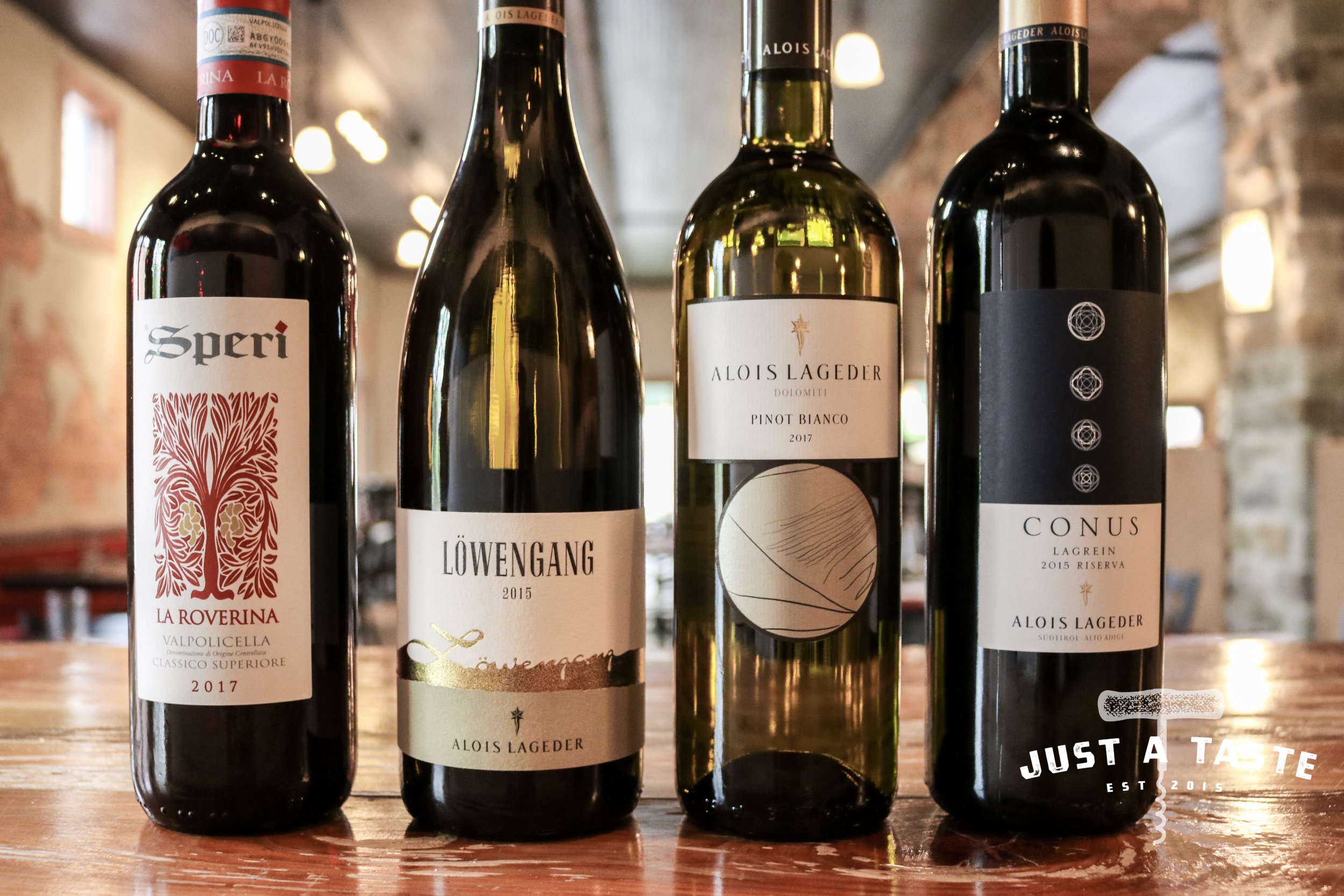Alois Lageder Lowengang Chardonnay and Alois Lageder Conus Lagrein are featured for the May 2019 Jefferson Club at Just A Taste. Interested in acquiring these wines? Click HERE!
“We see a vineyard as a living organism, as the product of a complex ecosystem. By taking account of the cycles and rhythms of nature, we can make use of their forces. We work with and not against nature. ”
- Alois Lageder
alois lageder
Several months ago, I had the opportunity to attend a luncheon with Alois Clemens Lageder, the 6th generation of Alois Lageder, a leader in viticulture in Italy’s Alto Adige region since the early 1800s. I was already familiar with their unique Pinot Grigio “Porer,” which completely breaks the stigma of a “simple Pinot Grigio,” but it was at this tasting that I was introduced into the philosophy behind Clemens’ wines. The highlight of the tasting was the opportunity to try the various elements that go into creating Porer, but that is for another article. Towards the conclusion of the tasting, I had a chance to speak directly with Clemens and asked him what he was currently geeking out over. His answer, “Lagrein.” This unique grape is native to Alto Adige and is growing in popularity around the globe.
This month, for Just A Taste’s Jefferson Club, I am excited to feature two wines from Alois Lageder. First, the “Conus” Lagrein will be given to the majority of our club members. For those members who equally enjoy white wine, I have a special treat: Alois Lageder “Lowengang” Chardonnay.
Alois Lageder “Conus” Lagrein
Wine Snapshot: Alois Lageder “Conus” Lagrein Riserva 2015
Producer: Alois Lageder and Alois Clemens Lageder, the 5th and 6th generations of Lageder
Winemakers: Georg Meißner, Paola Tenaglia, Jo Pfisterer
Region: Italy, Alto Adige, Magrè
Grape Varietal(s): 100% Lagrein
Viticulture: biodynamic vineyards; sand, alluvial deposits, and dolomitic limestone; 230-320 meters (750-1,050 feet); 11-13 year-old vines
Method: hand-harvested grapes; spontaneous fermentation; aged in stainless steel and neutral oak
Serving Suggestions: 60–65° F decanted with pork, schnitzel, or wurst
Age: Drink now through 2023
Tasting Notes:
Nose: fresh strawberries and black raspberries with pepper, spice, a hint of flint and gravelly undertones
Palate: prominent black and red fruits with lively acidity, olive, garrigue (herbs de provence), with soft, silky tannins
Finish: the fresh fruit tones morph into savory herbs and olive with a unique salinity that carries out with interesting exchanges between fruit and spice
Alois Lageder Lowengang Chardonnay
Wine Snapshot: Alois Lageder “Lowengang” Chardonnay 2015
Producer: Alois Lageder and Alois Clemens Lageder
Region: Italy, Alto Adige, Magrè
Grape Varietal(s): 100% Chardonnay
Viticulture: biodynamic vineyards; sand, gravel, and dolomitic limestone; 230-320 meters (750-1,050 feet); 30 year-old vines
Method: hand-harvested grapes; spontaneous fermentation; aged on the lees in oak barrels for 11 months
Serving Suggestions: 44-48° F with shellfish, chicken, or gnocchi
Age: Drink now through 2025
Tasting Notes:
Nose: yellow pear, quince, and lemon zest with creme fraiche, almond, and buttered bread
Palate: rich, ripe tropical fruit with oak spices
Finish: freshness, with a perfect harmony between acidity, body, and tannin with a clean lingering taste of pear and cream
About the alto adige winegrowing region
For an introductory look into Alto Adige, check out the May Heritage Club blog, or if you haven’t already checked out Madeline Puckette’s Winefolly, take a look at this article. I will wait.
Thank you.
Map of Alto Adige (Sudtirol) from Muller-Thurgau.com.
Alto-Adige has a long history of cultivating vines, beginning as early as the Roman Empire, but the reason this region is so suitable to grapegrowing goes back millenia. A combination of glacial drifts and runoff from the Alps slowly formed what is the Y-shaped valley of Alto Adige, carving into the Dolomitic limestone and breaking up the soil to create well-draining soils.
Though it is known primarily for energetic white wines, Alto-Adige is also home to a range of reds. The Schiava grape makes simple table wines, but this is also the home of the unique Lagrein grape. These two local reds are the most widely planted, but since the 19th century, you can also find Pinot Noir along with Merlot, Cabernet Franc, and Cabernet Sauvignon in some of the warmer sites. In fact, Alto-Adige is home to no fewer than 20 different vairetals due to a wide array of micro-climates with unique growing conditions.
Alois Lageder’s colorful vineyards, courtesy of Italian Wine Blog Vino Travels.
Dolomitic Limestone from Suedtiroler Weinstrausse.
About Alois Lageder
Weingut Alois Lageder is celebrating almost 200 years within the wine business, but their milestones took place within the past century. In 1934, Alois Lageder III, great-grandson of founder Johann Lageder, purchased the Lowengang vineyard outside the village of Magre. However, more recently, Alois IV Lageder moved the family estate from its origins in Bolzano to Magre due to their love of this particular site.
In the 1980s, Alois IV received a visit from an American oenologist by the name of Robert Mondavi. Like with his many other projects around the world, he recommended the use of more modern procedures with international varietals. This led Lageder to becoming the first winery in the region to experiment with aging chardonnay in smaller oak casts on the lees and reducing yields in the vineyards to increase ripeness. The result was the Lowengang Chardonnay, which instantly received world-wide recognition.
Read more with this interview with Alois Clemens Lageder.
Alois Lageder’s drive to better their wines continues to this day, and their new focus on been on increasing the quality in the vineyard, but not in the traditional sense. There are many ways to improve ripeness and quality in the finished grapes, such as eliminating competing elements, restricting yields by artificial ways, and introducing specific cultures; however, that is the thought of monoculture farming. Instead, Lageder has chosen to follow along the teachings of Dr. Rudolf Steiner with his philosophy of biodynamics. There are many intricacies to this philosophy and how it is utilized in the vineyard, but the basic principle is one of biodiversity. By introducing several natural elements into your vineyard, everything will benefit. One story in particular that piqued my interest was how Lageder will bring cattle down from the dairy at the top of the hills into the valley floors during winter where it is warmer. This allows the cattle to roam freely outdoors every day of the year. (Learn more about this practice, transhumance, in the video below.)
Alois Clemens Lageder with their newly launched “Comets” line.
“I think the most important thing is to say that Alto Adige is the most northern region of Italy. And it’s a beautiful mixture of huge diversity. It’s a mixture of two cultures. And then another beautiful thing about Alto Adige, and I think what’s unique about the region, is that we are in the middle of the Alps, in the middle of the Dolomites, and we can play with a beautiful diversity. We can play with different soil types we have. And so it’s about this playground with this huge diversity, with different soil types, with different microclimates, with different elevation. And this makes it possible to have so many different grape varieties. So I would say our identity, and that’s something special about Alto Adige, our identity is the diversity. ”
Alois Clemens Lageder on Transhumance.
Change settings to Auto-Translate to English.






